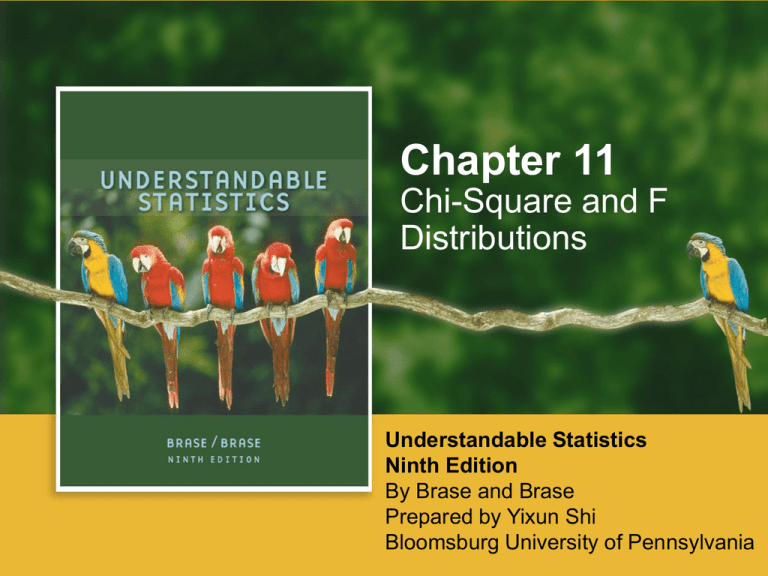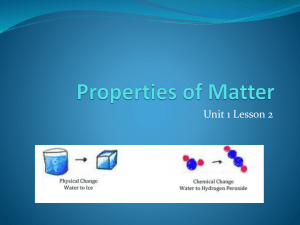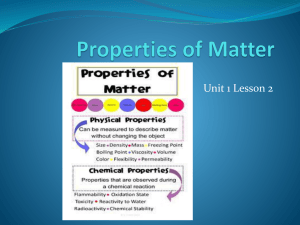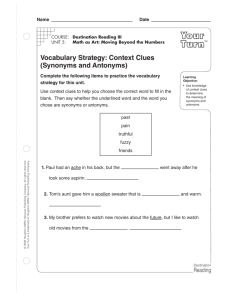
Chapter 11
Chi-Square and F
Distributions
Understandable Statistics
Ninth Edition
By Brase and Brase
Prepared by Yixun Shi
Bloomsburg University of Pennsylvania
The Chi-Square Distribution
• The χ2 distribution has the following features:
– All possible values are positive.
– The distribution is determined solely by the
degrees of freedom.
– The graph of the distribution is skewed right,
but as the degrees of freedom increase, the
distribution becomes more bell-shaped.
– The mode of the distribution is at n – 2 (for
sample sizes greater than 3).
Copyright © Houghton Mifflin Harcourt Publishing Company. All rights reserved.
11 | 2
The Chi-Square Distribution
Copyright © Houghton Mifflin Harcourt Publishing Company. All rights reserved.
11 | 3
Table 7 in Appendix II
• The table gives critical values for area that falls
to the right of the critical value.
Copyright © Houghton Mifflin Harcourt Publishing Company. All rights reserved.
11 | 4
Chi-Square: Test of Independence
• The goal of the test is to determine if one
qualitative variable is independent of another
qualitative variable.
• The hypotheses of the test:
H0: The variables are independent
H1: The variables are not independent
Copyright © Houghton Mifflin Harcourt Publishing Company. All rights reserved.
11 | 5
Chi-Square: Test of Independence
• The data will be presented in a contingency
table in which the rows will represent one
variable and the columns will represent the
other variable.
Copyright © Houghton Mifflin Harcourt Publishing Company. All rights reserved.
11 | 6
Chi-Square: Test of Independence
• First, we need to compute the expected
frequency, E, in each cell.
Copyright © Houghton Mifflin Harcourt Publishing Company. All rights reserved.
11 | 7
Chi-Square: Test of Independence
• The sample statistic for the test will be:
O = the observed frequency in each cell
E = the expected frequency in each cell
n = the total sample size
Copyright © Houghton Mifflin Harcourt Publishing Company. All rights reserved.
11 | 8
Chi-Square: Test of Independence
• To use Table 7 to estimate the P-value of the
test, the degrees of freedom are:
Copyright © Houghton Mifflin Harcourt Publishing Company. All rights reserved.
11 | 9
Review of Chi-Square Test for
Independence
Copyright © Houghton Mifflin Harcourt Publishing Company. All rights reserved.
11 | 10
Review of Chi-Square Test for
Independence
Copyright © Houghton Mifflin Harcourt Publishing Company. All rights reserved.
11 | 11
Review of Chi-Square Test for
Independence
Copyright © Houghton Mifflin Harcourt Publishing Company. All rights reserved.
11 | 12
Test of Homogeneity
• A test of homogeneity tests the claim that
different populations share the same
proportions of specified characteristics.
• Test of homogeneity is also conducted using
contingency tables and the chi-square
distribution.
Copyright © Houghton Mifflin Harcourt Publishing Company. All rights reserved.
11 | 13
Test of Homogeneity
Obtain random samples from each of the population. For
each population, determine the numbers that share a distinct
specified characteristic. Make a contingency table with the
different populations as the rows (or columns) and the
characteristics as the columns (or rows). The values
recorded in the cells of the table are the observed value O
taken from the samples.
1. Set the level of significance and use the hypotheses
H0: The proportion of each population sharing specified
characteristics is the same for all populations.
H1: The proportion of each population sharing specified
characteristics is not the same for all populations.
2. Follow steps 2—5 of the procedure used to test for
independence.
Copyright © Houghton Mifflin Harcourt Publishing Company. All rights reserved.
11 | 14
Chi-Square: Goodness of Fit
• We will test whether a given data set “fits” a
given distribution.
H0: The population fits the given distribution.
H1: The population has a different distribution.
Copyright © Houghton Mifflin Harcourt Publishing Company. All rights reserved.
11 | 15
Chi-Square: Goodness of Fit
Copyright © Houghton Mifflin Harcourt Publishing Company. All rights reserved.
11 | 16
Chi-Square: Goodness of Fit
Copyright © Houghton Mifflin Harcourt Publishing Company. All rights reserved.
11 | 17
Chi-Square: Goodness of Fit
Copyright © Houghton Mifflin Harcourt Publishing Company. All rights reserved.
11 | 18
Testing σ2
• If we have a normal population with variance σ2
and a random sample of n measurements with
sample variance s2, then
has a chi-square distribution with n – 1 degrees
of freedom.
Copyright © Houghton Mifflin Harcourt Publishing Company. All rights reserved.
11 | 19
Working with the
Chi-Square Distribution
Use Table 7 in Appendix II.
Copyright © Houghton Mifflin Harcourt Publishing Company. All rights reserved.
11 | 20
P-Values for Chi-Square Tests
Copyright © Houghton Mifflin Harcourt Publishing Company. All rights reserved.
11 | 21
P-Values for Chi-Square Tests
Copyright © Houghton Mifflin Harcourt Publishing Company. All rights reserved.
11 | 22
P-Values for Chi-Square Tests
Copyright © Houghton Mifflin Harcourt Publishing Company. All rights reserved.
11 | 23
Test Procedure for σ2
Copyright © Houghton Mifflin Harcourt Publishing Company. All rights reserved.
11 | 24
Test Procedure for σ2
Copyright © Houghton Mifflin Harcourt Publishing Company. All rights reserved.
11 | 25
Confidence Intervals for σ2
Confidence Intervals for σ
Copyright © Houghton Mifflin Harcourt Publishing Company. All rights reserved.
11 | 26
Confidence Intervals for σ2 or σ
Copyright © Houghton Mifflin Harcourt Publishing Company. All rights reserved.
11 | 27
Using the Chi-Square
Distribution for C.I.
Copyright © Houghton Mifflin Harcourt Publishing Company. All rights reserved.
11 | 28
Testing Two Variances
• Assumptions:
– The two populations are independent of
each other.
– Both populations have a normal distribution
(not necessarily the same).
Copyright © Houghton Mifflin Harcourt Publishing Company. All rights reserved.
11 | 29
Notation
• We choose population 1 to have the larger
sample variance, i.e. s21 ≥ s22.
Copyright © Houghton Mifflin Harcourt Publishing Company. All rights reserved.
11 | 30
More Notation
Copyright © Houghton Mifflin Harcourt Publishing Company. All rights reserved.
11 | 31
Compute the Test Statistic
We will compare the test statistic to an F
distribution, found in Table 8 of Appendix II.
Copyright © Houghton Mifflin Harcourt Publishing Company. All rights reserved.
11 | 32
A Typical F Distribution
Copyright © Houghton Mifflin Harcourt Publishing Company. All rights reserved.
11 | 33
Properties of the F Distribution
Copyright © Houghton Mifflin Harcourt Publishing Company. All rights reserved.
11 | 34
Testing Two Variances
Using F Distribution
• Use the F-distribution and the type of test to
find or estimate the P-value with Table 8 of
Appendix II.
• Conclude the test. If P-value , then reject
H0. Otherwise do not reject H0.
• Interpret your conclusion in the context of the
application.
Copyright © Houghton Mifflin Harcourt Publishing Company. All rights reserved.
11 | 35
Using Table 8
Estimate the P-Value for F = 55.2 with d.f.N = 3 and d.f.D = 2
Copyright © Houghton Mifflin Harcourt Publishing Company. All rights reserved.
11 | 36
One-Way ANOVA
• ANOVA is a method of comparing the means of
multiple populations at once instead of
completing a series of 2-population tests.
Copyright © Houghton Mifflin Harcourt Publishing Company. All rights reserved.
11 | 37
ANOVA Assumptions
Copyright © Houghton Mifflin Harcourt Publishing Company. All rights reserved.
11 | 38
Establishing the Hypotheses in ANOVA
In ANOVA, there are k groups and k group means.
The general problem is to determine if there exists a
difference among the group means.
Copyright © Houghton Mifflin Harcourt Publishing Company. All rights reserved.
11 | 39
One-Way ANOVA Procedure
Copyright © Houghton Mifflin Harcourt Publishing Company. All rights reserved.
11 | 40
One-Way ANOVA Procedure
Copyright © Houghton Mifflin Harcourt Publishing Company. All rights reserved.
11 | 41
One-Way ANOVA Procedure
Copyright © Houghton Mifflin Harcourt Publishing Company. All rights reserved.
11 | 42
One-Way ANOVA Procedure
Copyright © Houghton Mifflin Harcourt Publishing Company. All rights reserved.
11 | 43
One-Way ANOVA Procedure
Copyright © Houghton Mifflin Harcourt Publishing Company. All rights reserved.
11 | 44
One-Way ANOVA Procedure
Copyright © Houghton Mifflin Harcourt Publishing Company. All rights reserved.
11 | 45
Two-Way ANOVA
• Two-Way ANOVA is a statistical technique to
study two variables simultaneously.
• Each variable is called a factor.
• Each factor can have multiple levels.
• We can study the different means of the factors
as well as the interaction between the factors.
Copyright © Houghton Mifflin Harcourt Publishing Company. All rights reserved.
11 | 46
Two-Way ANOVA Assumptions
Copyright © Houghton Mifflin Harcourt Publishing Company. All rights reserved.
11 | 47
Steps For Two-Way ANOVA
1)
2)
3)
4)
Establish the hypotheses.
Compute the Sums of Squares Values.
Compute the Mean Squares Values.
Compute the F Statistic for each factor and the
interaction.
5) Conclude the test.
Copyright © Houghton Mifflin Harcourt Publishing Company. All rights reserved.
11 | 48
Two-Way ANOVA Hypotheses
Copyright © Houghton Mifflin Harcourt Publishing Company. All rights reserved.
11 | 49
Compute the Mean Squares
Copyright © Houghton Mifflin Harcourt Publishing Company. All rights reserved.
11 | 50
Compute the F Statistics
Copyright © Houghton Mifflin Harcourt Publishing Company. All rights reserved.
11 | 51
Concluding the Test
• Check the P-Values on the computer output.
• Always perform the test for interaction first. If
you reject the test for interaction, you should
not test for a row or column variable effect.
Copyright © Houghton Mifflin Harcourt Publishing Company. All rights reserved.
11 | 52
Experimental Design
• Completely Randomized Design: Independent
random samples determine the individuals or
objects for each treatment group.
• Block Design: One of the factors is
predetermined and not randomized.
Copyright © Houghton Mifflin Harcourt Publishing Company. All rights reserved.
11 | 53



